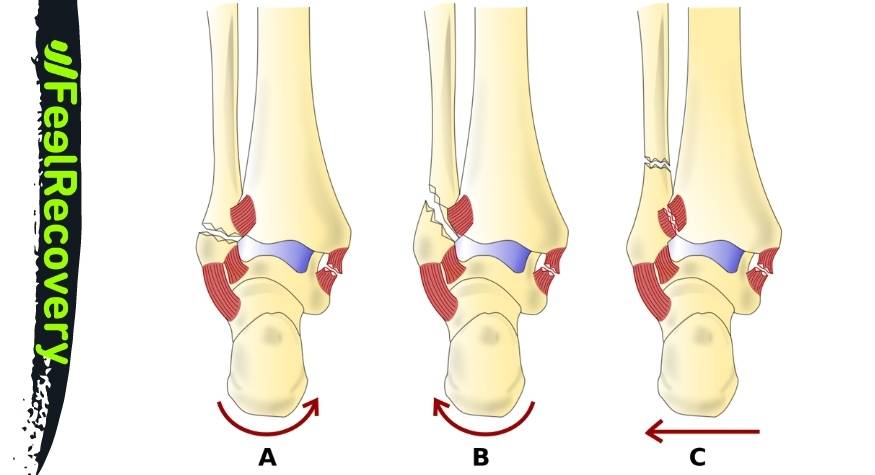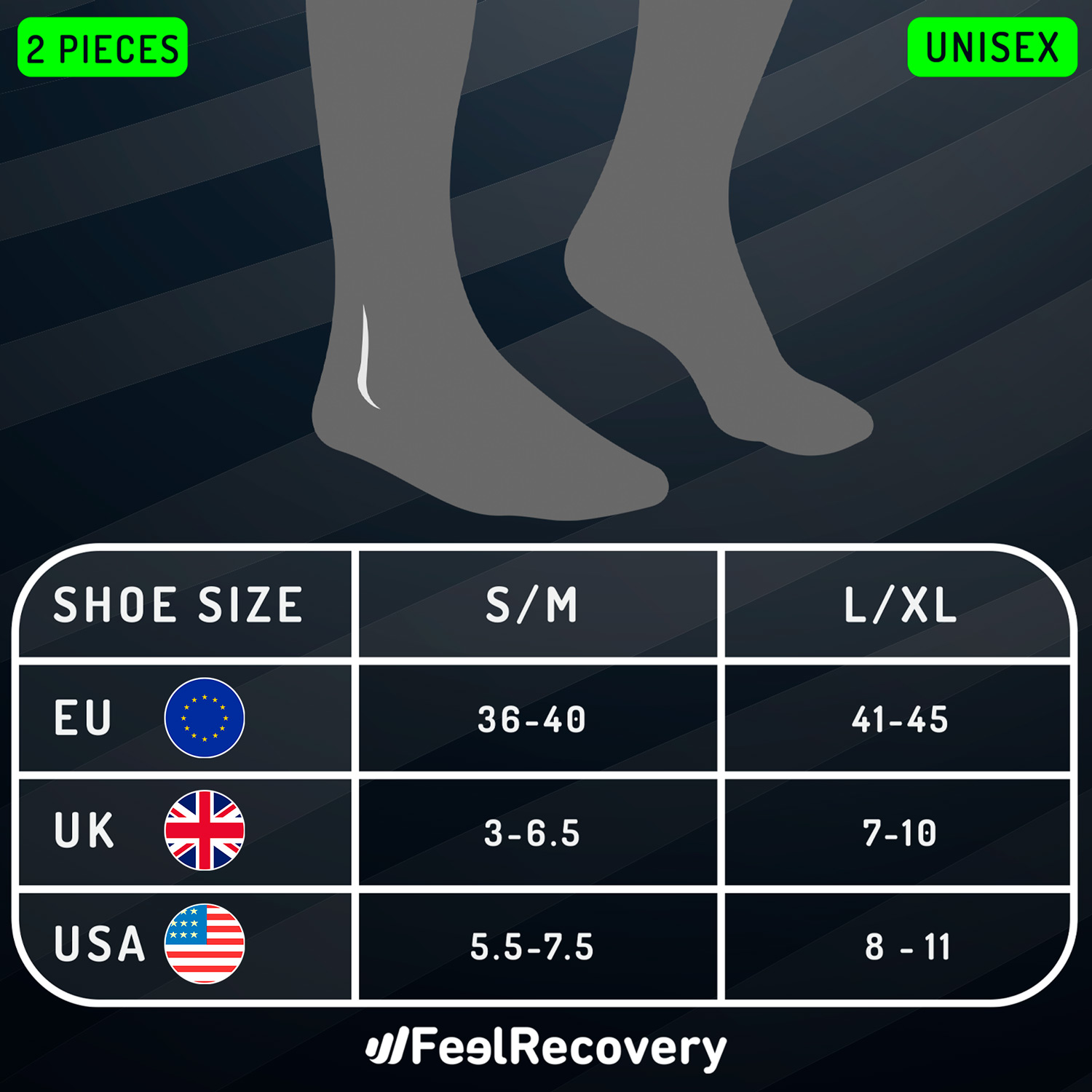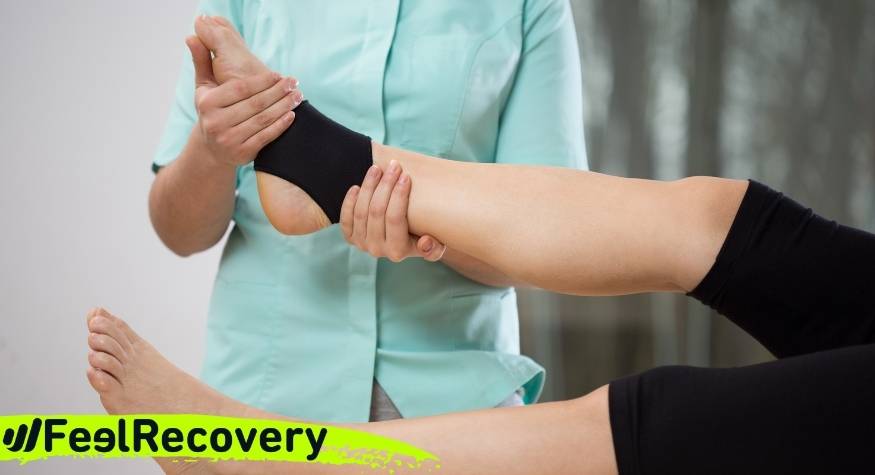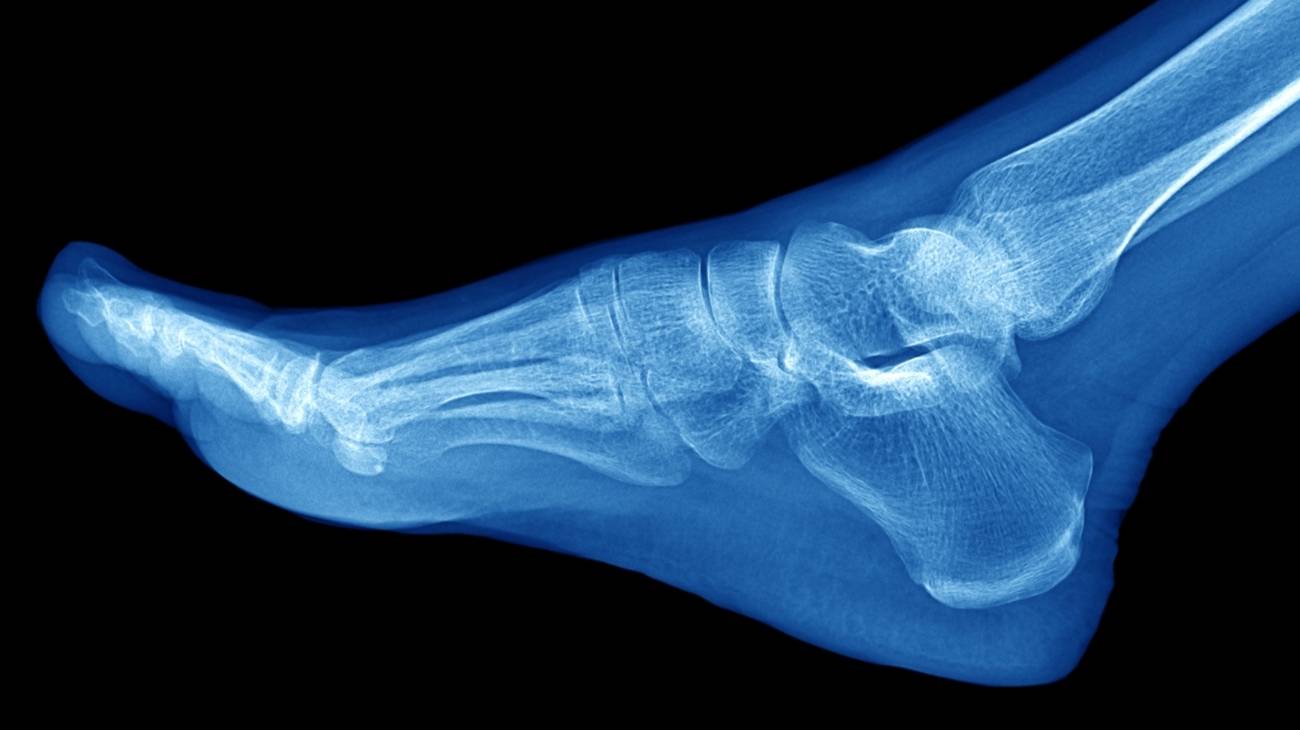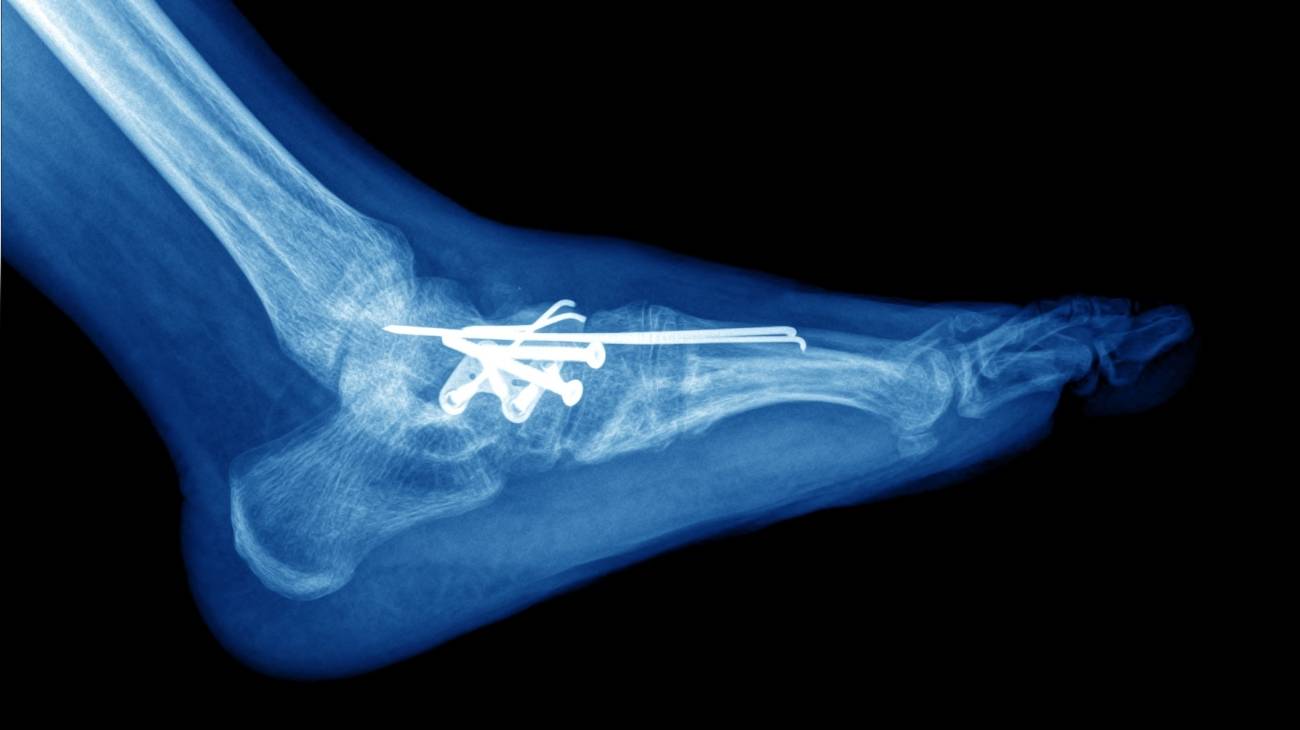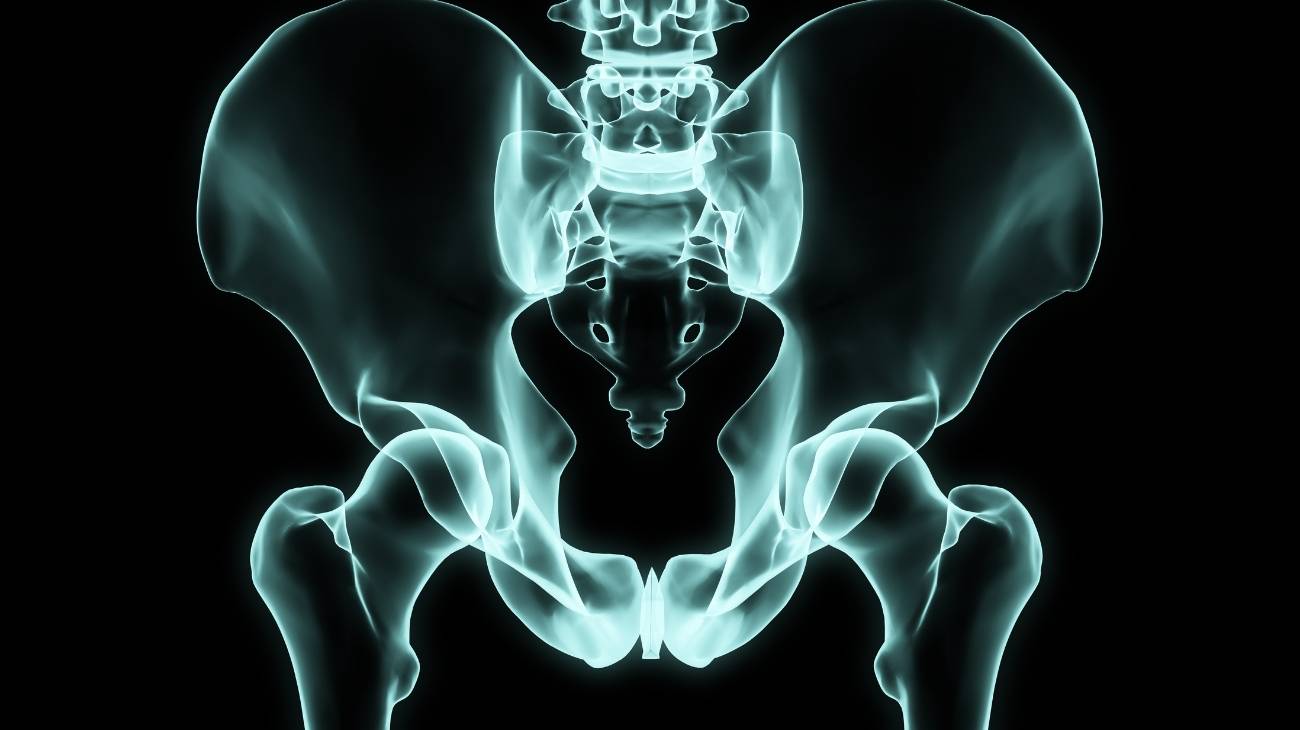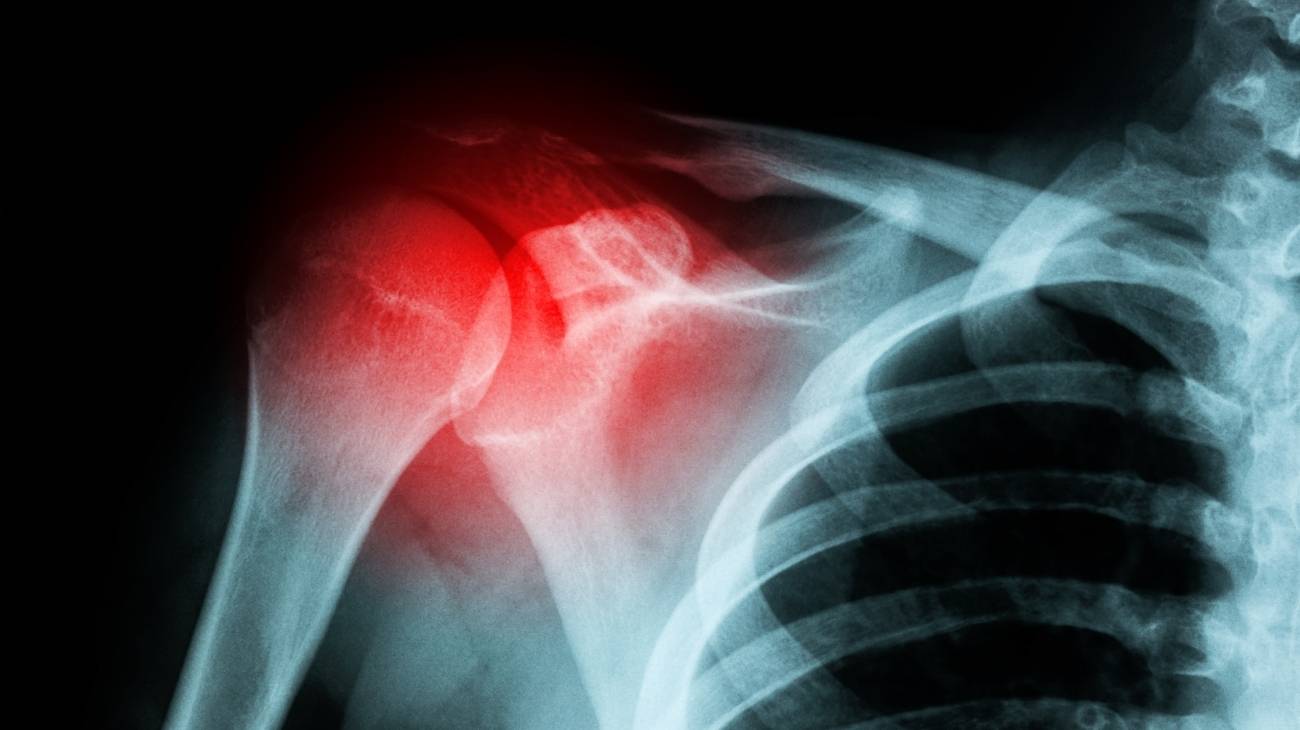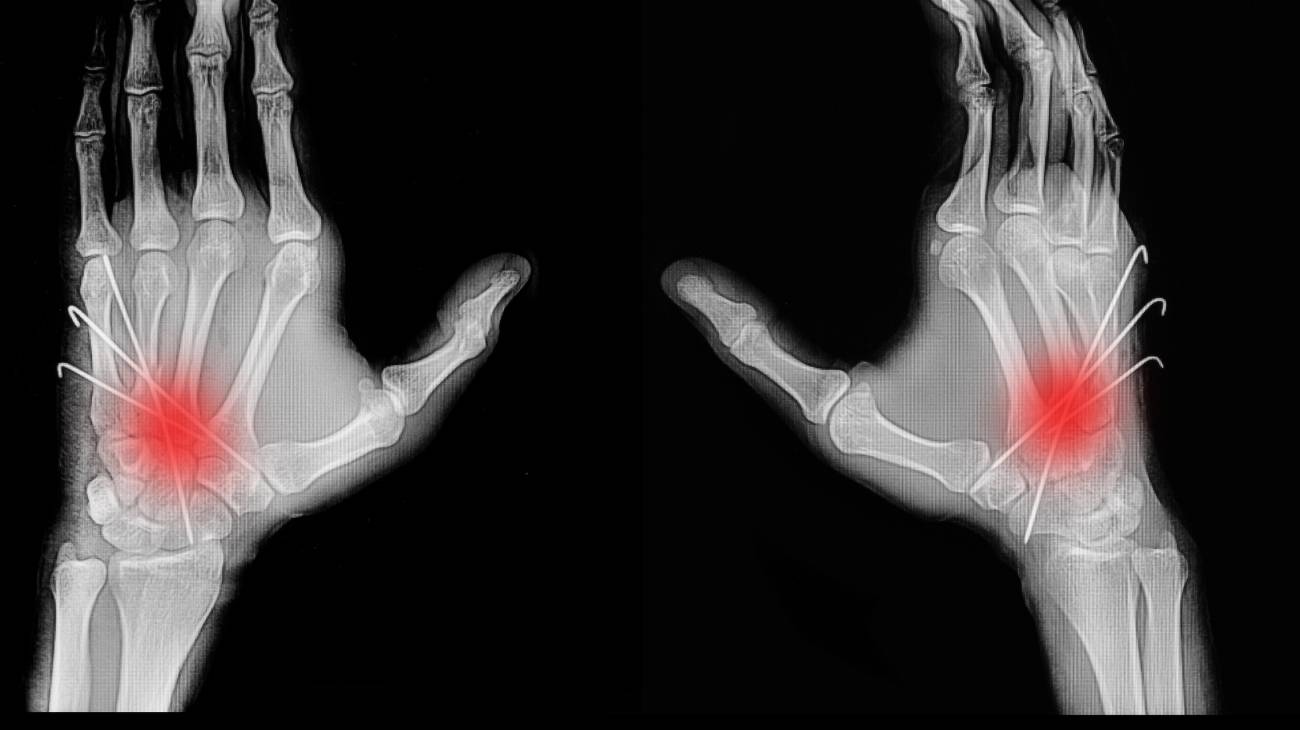- What is an ankle fracture and how is it diagnosed?
- What types of ankle bone fractures are there?
- Best products for ankle fractures
- What are the causes and risk factors for ankle fractures?
- First aid care for treating an ankle fracture
- Most indicated treatments for an ankle fracture
- Rehabilitation after a fracture of the foot and ankle
- Prevention methods to avoid broken bones in the ankle and feet
A fracture is the loss of continuity of a bone, caused by a break in the bone. Although there are many types of fractures, certainly one of the most common in emergency rooms are bone injuries that occur in the ankle and usually involve the distal ends of the tibia, fibula or both bones.
Typically, these types of fractures are caused by a sharp twist or trauma to the ankle. To learn more about the pathology, it is interesting to know how it is diagnosed, what classification it is, what causes it, how it should be treated and what methods of care are available to avoid it.
What is an ankle fracture and how is it diagnosed?
An ankle fracture or "broken ankle" refers to an injury that causes the breakage of a bone fragment located in this area of the lower limbs. As a result, it causes immediate, intense, throbbing pain, noticeable swelling, skin discolouration or bruising, deformity, tenderness to the touch and difficulty walking or bearing weight.
Since the ankle is composed of three vital bones (the fibula, tibia and talus) for optimal joint function, any one of these can be affected by a broken bone. Considering that the connection between the tibia and fibula (held together by a strong fibrous membrane) and the anchorage of both to the talus, isolated fractures of one of the ankle bones do not alter bone stability. But if the condition affects more than one bone or impacts other structures, the severity of the case increases markedly.
Fractures of the ankle tend to involve one of the malleoli, which is the small bony prominence at the end of the tibia or fibula that functions as a support for the ankle joint.
These malleoli include:
- Medial malleolus (which belongs to the tibia).
- Lateral or posterior malleolus (corresponding to the fibula)
As for the diagnosis of this pathology, in addition to the obvious symptoms it presents, the doctor will perform to obtain as much detail as possible different imaging tests that allow to see the state of the broken bone internally.
The imaging tests that are suggested in most cases are the following:
- X-rays: Almost all ankle fractures can be visualised through an X-ray examination. For this, the technician performing the test will have to take pictures from several angles in order to obtain the greatest possible clarity and also so that the images of the affected bone do not overlap noticeably.
- Computed tomography: This is a type of test that also takes X-ray images from multiple angles, and additionally combines the techniques to make cross-sectional images of the internal structures of the body. This reveals more detail about the affected bone fragment and surrounding soft tissues. This, medically, is decisive in providing more effective treatment.
- Bone scan: This is a study in which the technician proceeds to inject a small amount of radioactive material into a vein and this is attracted to the bones of the body, especially those portions of bone that are damaged. In this way, it helps the doctor diagnose fractures that do not show up on x-rays. Thus, if it is a stress fracture of the ankle, it can be detected because it is seen as bright spots on the resulting element (this is not obtained with X-rays).
- Magnetic resonance imaging (MRI): This refers to a test that uses radio waves along with a powerful magnetic field to produce much more detailed images of the ligaments that help hold joints and bones (in this case, the ankle) together. As a result, it has the ability to reveal fractures that are not seen on X-rays, as well as being able to show ligaments and bones to rule out whether they have also been impacted by the injury.
What types of ankle bone fractures are there?
In general, the classification of an ankle fracture is based on the type of bone that was affected, and from this, the most specific type of injury a person suffers is determined.
The most common injury of all is the fibula fracture, which is further divided into the following types of breaks according to Weber's classification:
- Type A: This is a fracture that is generated by the lower part of the fibrous membrane (or syndesmosis) that connects the tibia and fibula. In this sense, there is direct involvement of the distal fibula and because of this, it is essential to assess the condition of the membrane. Since, when it breaks, the two bones separate and generate more mobility than usual in the talus (causing more severe pain).
- Type B: This refers to a fracture that is classified as "transidermal" and is specifically located at the level of the syndesmosis, precisely.
- Type C: In this case, the injury is located above the membrane and thus triggers an injury to the inner or tibial aspect of the leg, causing considerable instability. If there is a type C fibula fracture, it must be specified which class it is (because there are two subtypes): a fracture of the tibia or an involvement of the deltoid ligament, as well as a bimalleolar equivalent (there is no fracture, but the ligament has been damaged).
Known are open fractures and closed fractures and depending on their location, they are divided into the following types:
- Fracture of the distal extremity of the tibia: This is the most common of all and can be simple, bimalleolar or trimalleolar. If it involves the distal end of the tibia above the malleoli, it is referred to as a "tibial pylon fracture".
- Fracture of the tibial diaphysis: This is usually a type of fracture that is associated with additional injuries. These are divided into mild, moderate and severe.
- Tibial plateau fracture: This is a fracture that results in the breakage of the proximal extremity. As a consequence, as well as affecting the stability and movement of the ankle, it also affects the knee joint.
For talus fractures the Hawkins classification comprises the following types:
- Type I: A non-displaced injury.
- Type II: Associated with subtalar subluxation or subtalar dislocation.
- Type III: Referred to a subtalar and ankle dislocation.
- Type IV: Type III injury linked to astragalonavicular subluxation or dislocation.
Finally, for ankle bone fracture in global terms, the most common types of injuries are these:
- Displaced fracture: This is a condition in which the bony portions are displaced and, as a result, move from their normal anatomical location. As a result, they are misaligned.
- Non-displaced fracture: Unlike the above, this is based on an injury in which the bone fragments remain in their anatomical location, i.e. they are not displaced.
- Open fracture: In this case, the bone fragments impacted by the injury break the skin and are exposed to the environment. Due to the risk of infection, they are classified as highly urgent fractures.
- Transverse fracture: A transverse fracture is one in which the fracture line shows a horizontal line that is perpendicular to the axis of the tibia.
- Spiroid fracture: This refers to a type of fracture that, as a result, shows a spiral-shaped fracture line. It is usually produced by a twisting force.
- Oblique fracture: This is a type of fracture that has an angular pattern. It is also considered to be typically unstable.
- Comminuted fracture: This is a fracture that is characterised by splitting the affected bone into more than two fragments. As a result, it is also very unstable.
Best products for ankle fractures
Bestseller
-
2 Ankle Compression Sleeve (Black/Gray)
£17,50 -
2 Ankle Compression Sleeve (Green/Navy)
£17,50 -
2 Ankle Compression Sleeve (Pink/Bordeaux)
£17,50 -
Ice Pack for Foot - Cold Therapy Socks (Black)
£21,95 -
Ice Pack for Foot - Cold Therapy Socks (Green)
£21,95 -
Ice Pack for Foot - Cold Therapy Socks (Pink)
£21,95 -
Microwavable Heated Slippers (Hearts)
£21,50 -
Microwavable Heated Slippers (Oxford)
£21,50 -
Microwavable Heated Slippers (Sport)
£21,50 -
Microwaveable Wheat Bag for Pain Relief (Hearts)
£17,50 -
Microwaveable Wheat Bag for Pain Relief (Oxford)
£17,50 -
Microwaveable Wheat Bag for Pain Relief (Sport)
£17,50 -
Sport Compression Socks (1 Pair) (Black/Gray)
£17,50 -
Sport Compression Socks (1 Pair) (Green/Navy)
£17,50 -
Sport Compression Socks (1 Pair) (Pink/Bordeaux)
£17,50
What are the causes and risk factors for ankle fractures?
While it is true, the reasons for an ankle fracture vary. For, it is a broken bone that can be triggered by numerous reasons or risk factors that increase the likelihood of ankle injury.
Here we specify the most common causes of a break involving one or more bone fragments in the ankle:
- Falls: Either tripping and falling to the ground abruptly or landing on one's feet after jumping from a considerable height, for example.
- Direct blows or trauma to the ankle also trigger severe injuries, the most common of which is a bone fracture.
- A condition in this category results from a twisting injury or sprained ankle.
- Slips or any accident that a person suffers while walking or running and misplaces his or her foot on the ground are other causes of an ankle sprain injury and, as a consequence, a broken ankle bone.
- If an individual experiences a traffic accident, whether by car or motorbike, it is very likely that he or she will suffer an ankle fracture. Since, it is one of the most common crush injuries during these eventualities.
- Osteoporosis or other conditions that decrease bone density or weaken bones directly, also increase the chances of injuring your ankle bones.
- The practice of high-impact sports: Whether gymnastics, basketball, football, tennis, etc.. They tend to lead to overload, twisting injuries or direct impact.
- If you exercise and increase the level of activity (in terms of frequency, duration or intensity) suddenly, it is also possible to trigger a stress fracture in the ankle area.
- Improper movements during physical activity, using the wrong techniques or using contraindicated sports equipment are risk factors for falls and stress fractures. This very commonly leads to broken bones in the lower limbs.
- Bad habits, such as smoking, drinking alcohol and poor diet, increase the risk of ankle bone fracture. Either through the development of osteoporosis, bone loss or weakening of these structures.
- Age is a cause of this type of injury: As the bones become weaker and more fragile over the years, they are prone to break easily.
First aid care for treating an ankle fracture
When treating an ankle fracture, the most important thing to do is to call for trained medical help to assist the injured person. It is also considered essential that the patient himself or the people who are trying to help him have a series of steps to follow to prevent the severity of the injury from increasing significantly and thus safeguard the health of the injured person.
The following first aid measures are to be taken:
- Immobilise the patient's ankle: First of all, it is vital to quickly immobilise the affected person's ankle and foot with removable plastic boots, with any other element that allows the injured area to be kept static and encouraging the patient to keep the joint still. This will help to limit the pain and discomfort caused by the condition, as well as prevent the fracture from becoming more serious.
- It is not advisable to try to align the broken bone: Another way to prevent the bone fracture from becoming more serious is to leave the broken bone as it is after the impact. In other words, it is not appropriate to align it, push it in or even touch it. In this way, it is even possible to avoid bone infection in the case of an open fracture where the end of the bone protrudes through the skin.
- Monitor the individual's vital signs: It is also advisable to monitor vital signs, which are indicators of a patient's state of health. Thus, as far as possible, people trying to help her can take her pulse, measure her respiratory rate, blood pressure and blood pressure, temperature and check that she is conscious. It is worthwhile to prevent her from closing her eyes or falling asleep.
- Control or calm the patient's nervousness: Because of the impact and pain, the patient is likely to manifest a state of shock and nervousness, which can worsen the condition of the broken bone and increase their pain. It is therefore essential to help the patient to calm down and relax, to promote stability, while he can receive medical attention.
- Avoid consuming liquids, food or any medication: It is not appropriate for a fractured person to consume food, drink any liquid and much less, to self-medicate after experiencing the injury, in order to try to attenuate the symptomatological picture that he/she is suffering. Bearing in mind that the latter can generate dangerous collateral effects that can lead to other pathologies and worsen the patient's health.
- Applying cold compresses to the fractured area: Another way to help a fractured person is to apply cold compresses to the ankle. In view of the fact that cold has properties that provide an analgesic, anti-inflammatory and relaxing effect. It is counterproductive to use ice directly on the skin because it could cause burns.
Most indicated treatments for an ankle fracture
According to the diagnosis defined by the medical specialist, it will be possible to prescribe the most suitable treatment to improve the fracture in the ankle and speed up the patient's rehabilitation process. The main objective of the procedure to be followed is to enable the person to walk normally again.
The clinical regimen to be followed to treat the injury will depend on whether there is displacement of the broken bone fragments or not. If there is bone displacement in the ankle, surgery will be necessary to restore the bone to its inert form and provide it with its normal function.
In general, there are two types of treatment:
- Conservative treatment: This is used when there is no bone displacement in the ankle area. It basically starts with medication and medical supervision for a week to reduce the inflammation and, after this, to check that there is no displacement. Therefore, if it does not reveal a detachment, conservative treatment is maintained based on the immobilisation of the ankle with the application of a plaster splint or a plaster boot for approximately 6 to 8 weeks. During this period, the patient will have to use crutches and undergo physiotherapeutic treatment, and its evolution will depend on age and bone quality.
- Surgical treatment: In the event of bone displacement, surgery is required to put the bone parts back in place and thus restore the work that the ankle must do. This can be done by means of screws, a metal plate with screws or a rod implanted in the lower half of the bone to give stability to the bone. Once the instability has disappeared and the fracture has healed (until the membrane heals), it is possible to remove these materials from the inside of the ankle (especially if they protrude or cause pain).
Rehabilitation after a fracture of the foot and ankle
After any treatment, it is essential that the patient complies with a rehabilitation process that is effective in healing the fractured ankle. During the post-treatment or post-operative period, different physical therapy practices will be established to help gain mobility, balance, foot strength and proprioception.
The different rehabilitation exercises for an ankle bone fracture include:
- Mobilisation exercises: These are a series of programmed exercises designed to actively move all the ankle joints. They should be performed with the greatest possible range of motion and restore regular ankle function.
- Strengthening exercises: Basically, these are aimed at conditioning the ankle musculature with the objective of stimulating the ankle's capacity for its own movements and speeding up its correct connection with the lower limb. Therefore, they also promote mobility.
- Resistance exercises: These are indicated to strengthen the muscles near the ankle joint, as well as to give better support and increase the level of strength exhibited by the ankle. In particular, to be able to support the person's body weight.
- Stretching exercises: These refer to certain workouts that are performed to elongate the muscle-tendon structures. These also tend to optimise the mobility of the ankle, while respecting joint amplitude without being performed abruptly or causing pain in the area.
- Proprioception or re-education exercises: With this type of exercise, patients will be able to acquire adequate stabilisation of their ankle. Taking into account that they are characterised by guaranteeing the correct functioning of the locomotor system, improving walking and balance, as well as avoiding postural problems or injuries.
Prevention methods to avoid broken bones in the ankle and feet
Although in many cases, broken bones in the ankle are caused by an accident that is impossible to avoid, in reality, there are many methods of prevention to avoid other eventualities that present a risk of suffering this kind of pathology.
The following indications are of great help to prevent an ankle fracture:
- Do physical exercise constantly and gradually: By nature, sport is capable of increasing the amount of bone, strengthening muscles and stimulating joint health. For this reason, it is recommended to exercise constantly to reduce the risk factors of suffering a broken bone. It is also important to do it gradually because overtraining often leads to injuries that break bones.
- Strengthen your ankle muscles: If you have found that you are prone to spraining your ankle, we recommend that you visit a doctor specialised in this area who will study your case and suggest different useful exercises to strengthen the muscles that support the ankle. In this way, you will be able to avoid a bone fracture.
- Opt for alternatingtraining sessions : The fact of alternating or relieving sporting activities helps to prevent stress fractures that break bones suddenly. In this case, it is recommended to walk, run, swim and cycle in turn.
- Wear the right shoes: When playing sports, it is essential that you wear shoes that are suitable for certain skills, fit your feet perfectly and, if possible, even have a non-slip sole. This makes it easier to prevent falls that lead to fractures. It is also appropriate to replace sports shoes periodically (especially if they show uneven wear) and to wear high heels sparingly (or occasionally).
- Don't forget to wear appropriate protective equipment: To avoid severe blows or trauma to the ankles leading to broken ankle bones, it is also important to wear protective equipment during sports activities, especially if they are high-risk. In this case, be sure to use compression ankle supports or bandages suitable for the area.
- Have a healthy and balanced diet: Another effective formula to prevent ankle fractures is to eat healthy and balanced food so that the body can function optimally. In the same way, it is recommended to have a diet high in calcium and vitamin D, because these substances support the development of bone strength and prevent bone weakness. This can be supplemented with nutritional supplements that provide their properties.
- Avoid unhealthy habits: Just as it is ideal to prevent sedentary lifestyles and eating disorders, it is also important to stop smoking and drinking alcohol. Tobacco favours the development of osteoporosis and alcohol causes bone loss, as well as facilitating falls and traffic accidents. These are therefore considered to be harmful practices that lead to bone fractures.
- Keep the floor of your house clear: In order to avoid falls that lead to domestic accidents, it is recommended to keep the floor completely clear for walking without the risk of tripping. To do this, you should make sure to keep it free of clutter, as well as stop using slippery wax when cleaning, remove loose cables and shifting carpets, leave furniture or decorative objects in their usual place, etc.
- Hold on to handrails when going up or down stairs: It is appropriate to hold on to the handrails on either side of the stairs when going up or down stairs to prevent falls. Also, if you have stairs in your home, be sure to install light switches for good lighting, place handrails on both sides (if you don't have them) and tape bright tape on the steps to differentiate them more quickly and easily.
- Use non-slip mats in the kitchen area: It is recommended to place mats that prevent falls, both near the cooker and also near the sink. In addition, it is advisable to clean up spills of liquid or food once they occur so as not to suffer eventualities that could lead to broken bones in the ankle (this should be applied in any part of the house).
- Prevent falls in the bathrooms: Many people suffer impacts on the ankle due to falls in the shower and it is therefore advisable to place rubber mats that are non-slip and use bath slippers that prevent slipping on slippery surfaces. It is also advisable to install grab bars on the bathroom walls.
- Implement safety recommendations for outdoor activities: In other places outside your home, it is important to practice the following: Walk with complete caution in buildings with marble or highly polished tile floors, use a cane or walker if required, walk in low-heeled shoes with rubber soles, keep your hands free, avoid walking in dark or poorly lit places, and be extra careful when driving or riding a bicycle.
References
- Court-Brown, C. M., McBirnie, J., & Wilson, G. (1998). Adult ankle fractures—an increasing problem?. Acta orthopaedica Scandinavica, 69(1), 43-47. https://www.tandfonline.com/doi/abs/10.3109/17453679809002355
- Strauss, E. J., & Egol, K. A. (2007). The management of ankle fractures in the elderly. Injury, 38(3), 2-9. https://www.sciencedirect.com/science/article/abs/pii/S0020138307003166
- Lin, C. W. C., Donkers, N. A., Refshauge, K. M., Beckenkamp, P. R., Khera, K., & Moseley, A. M. (2012). Rehabilitation for ankle fractures in adults. Cochrane database of systematic reviews, (11). https://www.cochranelibrary.com/cdsr/doi/10.1002/14651858.CD005595.pub3/full
- Daly, P. J., Fitzgerald, R. H., Melton, L. J., & Llstrup, D. M. (1987). Epidemiology of ankle fractures in Rochester, Minnesota. Acta Orthopaedica Scandinavica, 58(5), 539-544. https://www.tandfonline.com/doi/abs/10.3109/17453678709146395
- Hughes, J. L., Weber, H., Willenegger, H. K. E. H., & Kuner, E. H. (1979). Evaluation of ankle fractures: non-operative and operative treatment. Clinical Orthopaedics and Related Research (1976-2007), 138, 111-119. https://journals.lww.com/corr/Citation/1979/01000/Evaluation_of_Ankle_Fractures__Non_operative_and.21.aspx
- Müller, M. E., Nazarian, S., Koch, P., & Schatzker, J. (2012). The comprehensive classification of fractures of long bones. Springer Science & Business Media. https://books.google.es/books?hl=en&lr=&id=t0CgBQAAQBAJ
- Watson-Jones, R. (1962). Fractures and joint injuries. E. & S. Livingstone. http://117.239.25.194:7000/jspui/bitstream/123456789/1853/7/INDEX.pdf
- Hoppenfeld, S., & Murthy, V. L. (Eds.). (2000). Treatment and rehabilitation of fractures. Lippincott Williams & Wilkins. https://books.google.com/books?hl=en&lr=&id=bxhycwgJUtQC
- Kanis, J. A., Borgstrom, F., De Laet, C., Johansson, H., Johnell, O., Jonsson, B., … & Khaltaev, N. (2005). Assessment of fracture risk. Osteoporosis international, 16, 581-589. https://link.springer.com/article/10.1007/s00198-004-1780-5
- BAILEY, M. (1982). Emergency! First aid for fractures. Nursing2021, 12(11), 72-81. https://journals.lww.com/nursing/Citation/1982/11000/EMERGENCY__FIRST_AID_FOR_FRACTURES.22.aspx

